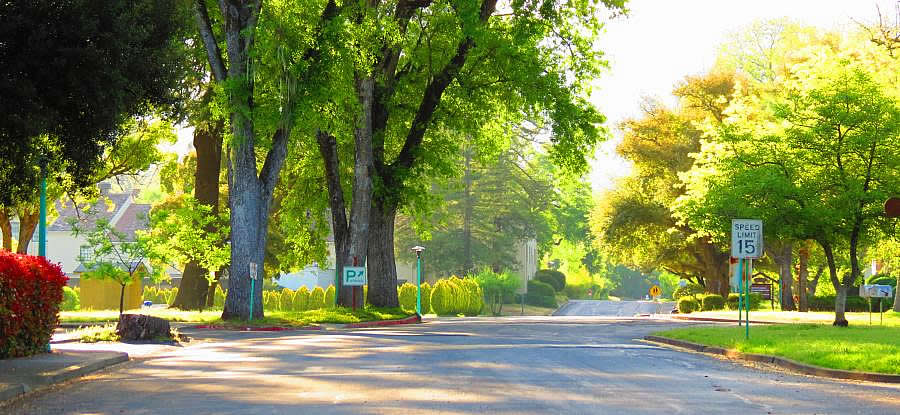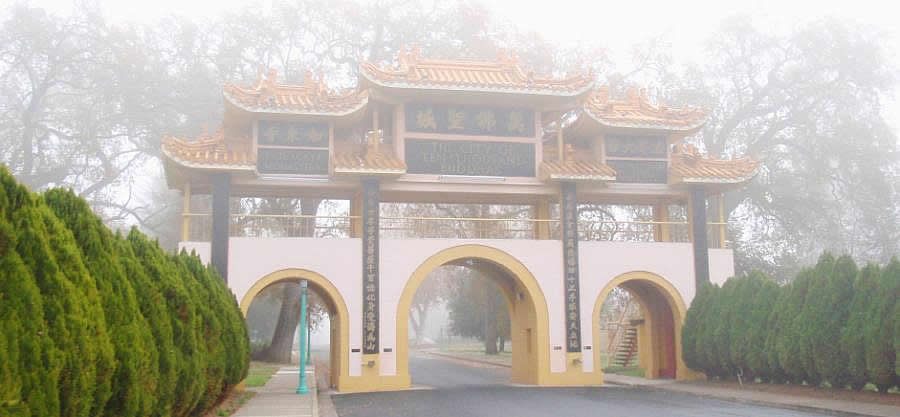 |
|
Seven Weeks at the
City of Ten Thousand Buddhas
By Zilong Wang, January 2017
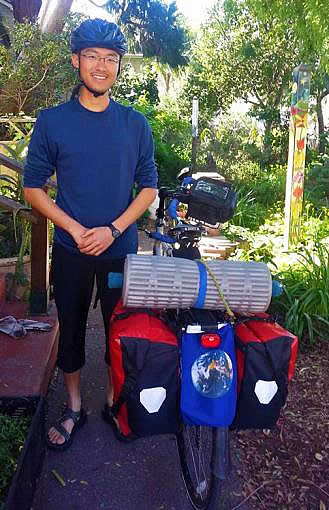
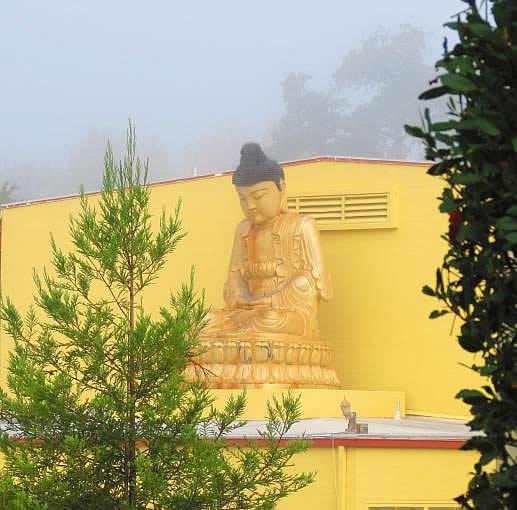
I had not planned on being there as part of my bicycling pilgrimage around the world, and certainly not for that long -- seven weeks at the City of Ten Thousand Buddhas (CTTB). It was a spontaneous decision, or perhaps a response to a deeper prayer, so deep that the conscious mind was not even aware of it.
I went in without any particular expectation, but came out with some of the most significant gifts a wayfarer could ever receive -- recognizing one's Teacher, making lifelong vows, learning to read the original sutras, exploring various dharma-doors (techniques of practice) and resolving upon one's own path… And the subtler impact of the seven-weeks at CTTB might take years -- or lifetimes -- to reveal itself.
The student feels an overwhelming grace and overflowing gratitude, and wishes to harvest some of the fruits as an offering to all.
A western pure land
The City of Ten Thousand Buddhas. There is simply no other place quite like it. How the City came to be, is a story in and of itself. CTTB is a Way Place of authentic Mahayana Buddhism tucked away in small town in Northern California. It is a mini-city of 700 acres of beautiful nature. In addition to the monastery and Buddha Hall, the City has a primary school, a secondary school, a liberal arts college, an organic farm, a half-megawatt solar farm that powers the whole campus, and many dozen free-roaming peacocks.
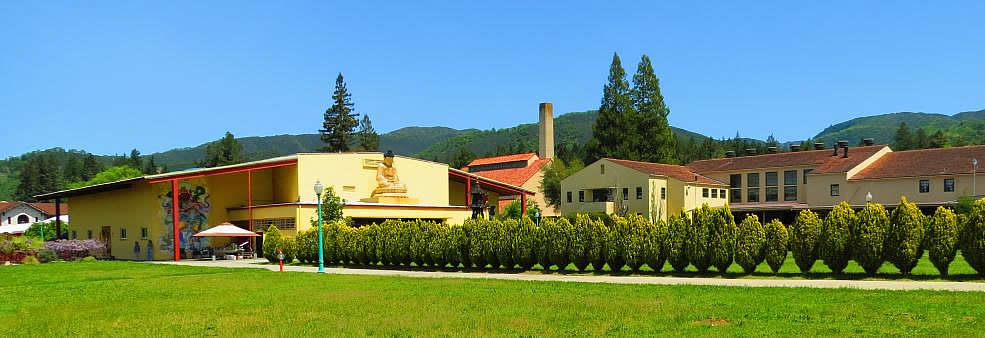
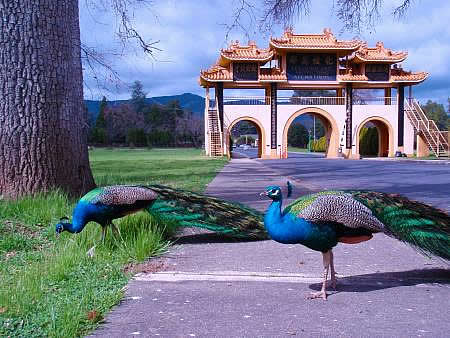
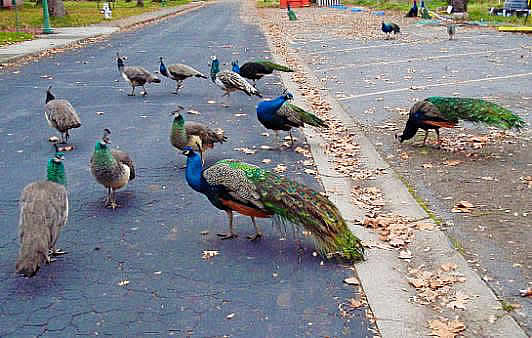
Those who live here are sincere and rigorous cultivators. Precepts are strictly observed. The community rises at 3:30 a.m. for an hour of morning recitation. The monastics eat only one vegetarian meal a day, and many "sleep" in sitting meditation posture every night.
(I joined the monastics in eating one meal a day for about a month. It was hard in the beginning. I would eat, in one meal, what I would usually eat in three meals, out of fear of hunger and craving for tastes. Gradually, I reduced the portion [and greed], and was eating slightly more than what I usually eat in one meal, which ended up being enough for the whole day. Made me realize how much food, time and energy I otherwise waste on unnecessary eating!)
Such a virtuous and diligent environment -- most conducive for cultivation -- is hard to find, not the least in the US, but throughout the world, even among Buddhist countries of Asia.
Forty years after the City's founding, and twenty years after the passing of the founder, Master Hua, the City continues to be a sacred place that propagates the Dharma and carries living beings over to the other shore. Who would have thought that a "western pure land" like this exist in the middle of Mendocino woods and wine country?
A Bodhisattva walked this land
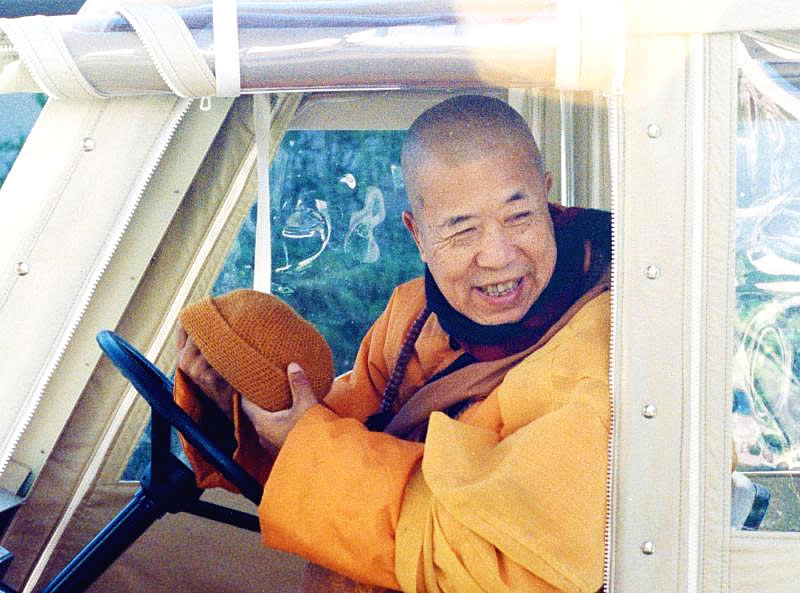
Master Hua, the founder of the City, is the teacher who brought Chinese Buddhism to the West, and the first Buddhist Master to establish an ordained sangha in the US. The best way I know to offer a glimpse into this Bodhisattva's life, is to quote some of his vows:
5. I vow that as long as there is a single human being in the worlds of the ten directions who has not accomplished Buddhahood, I too will not attain the right enlightenment.
10. I vow that as long as there is a single god, immortal, human, asura, air-bound or water-bound creature, animate or inanimate object, or a single dragon, beast, ghost, spirit, or the like of the spiritual realm that has taken refuge with me and has not accomplished Buddhahood, I too will not attain the right enlightenment.
11. I vow to fully dedicate all blessings and bliss which I myself ought to receive and enjoy to all living beings of the Dharma Realm.
12. I vow to fully take upon myself all sufferings and hardships of all living beings in the Dharma Realm.
16. I vow to enlighten all sentient beings, universally responding to the multitude of differing potentials.
17. I vow to obtain the five eyes, six spiritual powers, and the freedom of being able to fly in this very life.
These are some heavy-duty vows!
Finding my Teacher
It is one of the most significant moments in a seeker's life to have found his Teacher.
At CTTB, I realized that I have found my Teacher -- Master Hua. More precisely speaking, my Teacher has found me. And to be yet more accurate, my Teacher has never lost me: it is that his presence in my life has only now been revealed to my conscious mind, and that this ancient bond has only now been recognized and embraced with renewed commitment. This recognition has filled me with unspeakable joy and relief. It is like a lost child coming back to his mother again.
Grace and gratitude wash over me in this new knowing -- I am home. For a minute, like a spoiled child throwing a tantrum in front of an always loving mother, I asked the Teacher: why have you left me hanging for 25 years? Why have you waited for so long to call me back? The next moment, I knew that he had never left me; he just gave me the space to learn what I needed to learn. Ultimately, the Teacher is just a guide, not the final goal, nor he is not to be attached to.
Each of us have many teachers (with a lower-case "t") in life. But, each soul is under the compassionate watch of one particular Teacher, (with the upper-case "T") from lifetime to lifetime, from eon to eon. The Root Teacher is the Bodhisattva or guardian angel whom we have a personal affinity with, who watches over our spiritual evolution, and guides us along the path, until they deliver us to the final goal.
The Teacher may come into our life as an actual person, or he/she may meet us in our dreams or other numinous encounters. Some of us cultivate a conscious relationship with our Teacher, but most are perhaps unaware of their Teacher's presence.
In my case, I've never met Master Hua in this human life -- he passed on when I was 4 years old. I had not even heard of his name until three years ago. But time and space are irrelevant for the spiritual bond between the Teacher and disciple. It doesn't bother me the least that my Teacher is not in a physical body (that I know of). He teaches me through dreams. And his Dharma is very accessible through the living sangha he left behind.
Having a Teacher is to be able to lean on the light and strength of someone who has walked the Path. It is also surrender: I surrender my own opinions and doubts, and accept my Teacher's wisdom and guidance.
For example, Master Hua gives importance to the posture of sitting meditation, and encourage all disciples to eventually get into the full lotus position. Despite my doubts and very stiff joints, I now fully accept the primacy of the lotus posture, and am willing to work through the pain.
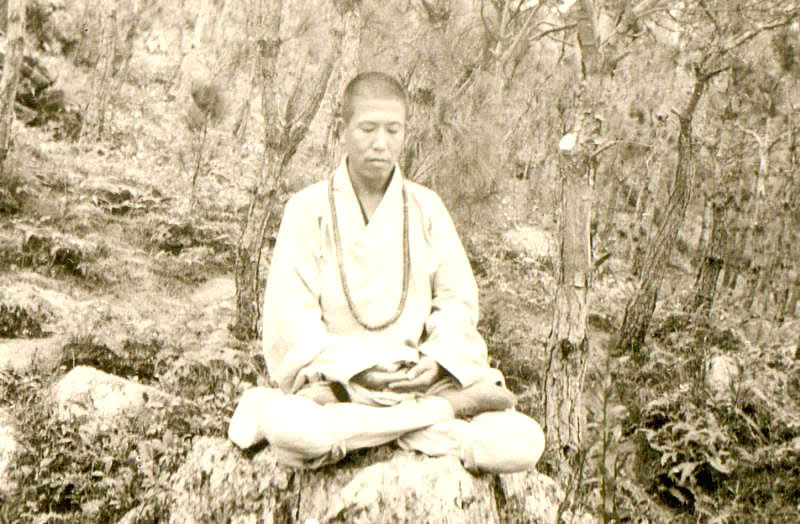
Recognizing the Teacher
It is hard to say what exactly made me realize that Master Hua is -- and has been -- my Teacher. I don't know the exact nature of our relationship in the past: Have I been a monk who took refuge under Master Hua? Have I been a lay disciple of his? Have I been a "sinner" whom he pulled back from the brink? I have no idea. But here are some pieces of evidence that confirm a deeper intuition.
First, the dream encounters with Master Hua are imprinted with a categorically different quality than any other dreams I've had.
This soul-knowledge alone should suffice in confirming the Master-disciple relationship, but my day-world doubting mind has to look for additional evidences for "due diligence"…
Second, Master Hua's teachings lands right in my heart. There is a special resonance and inexplicable joy in hearing his Dharma. There are many enlightened teachers with profound teachings, but not all of their teachings are equally digestible to us. It is like a nursing baby: the infant could survive drinking any women's milk or even synthetic baby formula, but it is his own mother's milk that is the most digestible and beneficial. Master Hua's teachings feel like "mother's milk" to my Dharma body.
Third, I feel a strong affinity with many other disciples/acquaintances of Master Hua. It is only logical: if we all have been in Master Hua's orbit for more than one lifetime, then there's a good chance that we have been bumping into each other for a long time, too. I think back on the noble friends who delivered me to Master Hua, and a light bulb comes on: Aha! We have known each other all along, and we are all connected to/through Master Hua! This recognition gives me a whole new appreciation for my affinities with some of my dearest friends.
Fourth, I realized that my life's work is deeply connected with Master Hua's vows. He has always been actively involved in worldly affairs -- but nowhere attached. He has built the platform that would become invaluable to my future work. (For example, he has played an instrumental role in establishing a peaceful relationship between US, China and Taiwan.) I do not yet know the exact way I would contribute to his work, but I am seeing the synchronicities emerging.
Teachings from the dreams
The personal teachings I receive from Master Hua mostly come through dreams. In the past year and a half, there has been at least four dreams of the Master, each of them arriving at an uncanny time during my pilgrimage.
I first learned about Master Hua through the book Highway Dharma Letters. A dear sister gifted me the book when I attended the Awakin Circle in Santa Clara for the first time in Fall 2013. In this books, two American Buddhist monks wrote to their Teacher -- Master Hua -- while they were on a three-step-one-bow pilgrimage for almost three years for world peace. For a few months, I would read a few pages of this book every morning, which set the tone for the rest of the day. It changed my life; the bowing pilgrimage is the most direct inspiration for the bicycling pilgrimage I am on. But at that time, I was more fascinated with the two monks accounts from the road, and did not think too much about the Master himself.
The dream-world connection with the Master started in summer 2015, when I was at a 10-day retreat with Gaian elder Joanna Macy. Up until Master Hua came into my life, Joanna has been one of my most important teachers. It is only natural that she would be the one to "deliver" me to my Teacher.
On a full moon night at the remote retreat center, I had the most profound dream in my life. In the dream, it was only a thirty-second interaction with Master Hua, but I woke up sobbing uncontrollably out of gratitude and awe. Ever since then, a seed was planted in my heart: who is this monk? Why does he come to my dream? Deep down, I knew right then that this was a most significant sign, but I was either too afraid or not yet ready to peel away at its meanings.
Interestingly, the night before, I also awoke from a dream crying. I dreamed that my mother had only one year left to live in this world. I woke up with heartbroken tears. (I am glad to report that my mom is well and healthy, a year and a half since that sad dream.)
Back then, I did not make a conscious connection between these two dreams, and was only surprised that I would wake up crying from dreams, two nights in a row. Only later did I realize that my mother's "passing" symbolized the end of my psychological dependence on my biological family, and the beginning of my spiritual refuge under my Dharma mother.
Synchronicity in life would have it that exactly one year on from the two back-to-back dreams, in summer 2016, I arrived at Buddha Root Farm (where Master Hua used to teach) to participate in a 2-week study session with Master Hua's sangha.
At the beginning of the study session, as I heard many Master Hua stories from those who knew him, I was feeling left-out that I did not have the good fortune to meet him in life, and that I could only receive "second hand" teachings through the Master's disciples. Then, that night, Master Hua came into my dream, and urged me to have faith in the Dharma, which was equally alive in the ministry of his disciples.
At Buddha Root Farm, one day we were asked the question, "What is the primary question/preoccupation in your life now?" My immediate response was, "Who is my Teacher?" This response surprised even myself, as I was never consciously looking for a Teacher. Perhaps it was a rhetorical question from my sub-consciousness that I was seeking affirmation on whether Master Hua was indeed my Teacher.
Most recently, I met Master Hua in a dream the day after I finished serving a 10-day Vipassana meditation course in India.
A few of us are chatting with Master Hua in a big cafeteria. Someone asks the Master about the growth in "computing power" and Artificial Intelligence. Master Hua says, "If you truly understand the Dharma, then you will have all the computing power you need. Much of the 'computing power' these days is devoted to 'computing' the wrong things, answering the wrong questions. What's the benefit?"
I ask Master Hua about his view on the Vipassana meditation technique. Master responds, "Vipassana is a very good technique. But it is also not the Dharma door for everyone. People have different roots and affinities."
While we are speaking, we are also eating dark red plums from a table. I keep gorging myself, but notice that Master Hua is cutting up the plums into pieces, and putting them on a plate for others to eat. I am very ashamed. I peel a big piece of plum, and want to offer it to Master Hua, but am too embarrassed to do so.
Then, I realize that, during all this time, I have not yet bowed to the Master. Just as I get ready to bow, the dream ends. As I slowly awake, I am very reluctant to leave the Master.
This dream is rich with teachings and symbolisms on many levels. I continue to receive new insights from it, even three months later. For example, the image of "sharing fruits" nudges me to open up the learnings from the Pilgrimage and offer it up for others.
The skillfulness of the Teacher to impart lessons is beyond our imagination.
Vows made me
In addition to recognizing my Teacher, another significant gift from the time at CTTB is about "vows". I finally had the courage and readiness to extend the six vows of the Pilgrimage to the rest of my life -- and for the lifetimes to come.
The vows are six precepts: no killing, no stealing, no lustfulness, no intoxicants, no meat-eating, no profit-seeking. These six precepts are the bare minimum of morality. They are the guardrails for the long Path ahead. They are my "insurance policy" against regressing too much. It is actually embarrassing to think how long it has taken me to even arrive at this low bar.
Five out of the six vows are relatively easy to extend to eternity, but I have been going back and forth on the vow of celibacy. The reasons are manifold. I had not been willing to "give up" the option to enjoy carnal pleasures. Nor did I have the confidence that I could tame the powerful "instinctual drive". What's more, I am the first grandson and the only male from both sides of my family. Confucian values dictate, "There are three great transgressions of one's filial duties. Foremost among them is to not produce an offspring."
However, on one of the last days of my time at CTTB, while reading the Shurangama Sutra during a break in the Chan session, something suddenly clicked in me. It became apparent that lust is suffering, and that catering to lust is more suffering. I became wholeheartedly willing to pull out the arrow of lust once and for all, and to forgo the fleeting satisfaction of sexual desires. In comparison to the true joy that is the "freedom from desires", the "satisfaction of desires" holds no temptation. It was an effortless and liberating "decision".
(Furthermore, I would have given up the satisfaction of taste-desires, if I could live without eating. Some enlightened masters could actually live without eating, but most of them still choose to eat, not for their bodily needs, but to set an example for the rest of us on how to properly relate to food and eating.)
The year of pilgrimage has given me the confidence that lust has largely come under control in myself; it no longer overpowers me. The seven weeks at CTTB and the power of the Shurangama Sutra gave me the final boost to cut off my attachment to the satisfaction of desires. If I can do nothing else in life, let me at least reduce the lustfulness in the universe by one unit.
The essence of the vow, "no lustfulness", is not to suppress sexual activities, but to fundamentally uproot lust and craving from the depth of the mind. People could be celibate on the bodily level, but still be full of lustful thoughts.
At long last, the way has been cleared for the vows to take root. So, on the night of January 5th 2017, I wrote the vows down in my diary, asking Master Hua and Bodhisattvas to be my witness and guide.
Two days later, a friend asked me, "Did you know that Jan 5th was the anniversary of Buddha's Enlightenment, which was the most auspicious day of the year to make vows?" I was speechless. I had no idea of this tradition, but the magic of CTTB was certainly working on another level, solidifying my vows on the exact day.
Actually, I did not make those vows; those vows made me. I only cleared a space for them to arrive.
They say, there are only two forces in our life: karma and vows. Karma is the habitual tendencies and reactive patterns we carry from moment to moment, life to life; vows are the intention to repent and reform, a conscious channeling of energy.
Recently, when I mentioned the "indefinite extension" of the six vows to Joanna Macy, she offered her blessing, and then, with a wink, she added, "The Buddha said, 'Anicca vata sankhara' -- all is impermanent. What does it mean to have permanent vows in a world of impermanence? Just a thought for you."
It might take me years to understand this koan.
My mother's evolution
On the same night when the "vows made me", I also wrote down in my notebook, and set an intention, that my dad and I might encourage my mom to join us for a 10-day Vipassana meditation course in our hometown in Inner Mongolia this coming Spring.
Ever since I sat my first Vipassana course in Fall 2014 -- which changed my life -- I have been wishing that my parents would also take the seeds of Dharma.
To my utter amazement, in Fall 2015, my dad -- an unlikely candidate -- signed up to sit a 10-day Vipassana course, and came out a changed person. He pretty much spent the ensuing six months sitting and serving at various meditation centers all over China, and continues to meditate two hours every day.
My mom has always supported my dad and I, but has not shown interests to attend a course herself. Objectively speaking, she has much higher IQ and greater virtue and merits than my dad and I -- quite a wonderful person to begin with. However, sometimes, smart people have additional barriers to overcome. Instead of the coarser impurities of "greed, hatred, delusion", the more evolved ones might fall victim to "arrogance and doubt". They think they are "doing just fine" and "do not need help". I once half-jokingly asked my mom why she resists meditation. She said matter-of-factly, "I like my 'self'. I am afraid that I would lose my 'self' if I meditate."
Friends who introduced me to Vipassana have done me the great favor of never pressuring me to go meditate. But, I had been feeling a sense of urgency in my mom's case because of the aforementioned dream which said that she had only one year left in this world. (It turned out that I had took the dream's metaphors too literally, and had needlessly worried myself for an entire year.) I thought that it would be such a loss if my mom miss out on encountering wholesome dharma. I even thought of praying to the Bodhisattvas: please take years off my human life to extend my mother's life, so that she would have time to sit a 10-day. Once my parents have set their intention on the path of liberation, then I would not worry when their physical forms would perish, because, once the seed is planted, its blossoming would only be a matter of time, in this life or another.
However, for two years, there has been no sign of mom's interests. Then, the day before I left CTTB, my mom suddenly told me on the phone that she will join my dad and I for the upcoming meditation course. I was dumbfounded and overjoyed -- one of the happiest moment of my life!
As I struggled for words in my excitement, I cautiously asked her, "Aren't you afraid of losing your 'self'?" She responded casually, "Oh, the 'self' is already lost. Now I need to go find it." How about that!
I then asked, "What made you change your mind?" She said, "It happened most naturally. One moment ago, I had no intention at all of going. But then, in a split-second, I thought, 'We might as well go meditate as a whole family'. After that, I have no doubt that I want to go. I didn't even think much about it."
I was smiling ear-to-ear on this side of the phone. It was as if my prayer had been answered. Be careful what vows or wishes you make on the anniversary of Buddha's Enlightenment!
So, this Spring, my parents and I will all join the same 10-day Vipassana course in our hometown in Inner Mongolia -- they will sit, I will serve.Enter the sutra treasury: wisdom like the sea
Every day at CTTB, we chant the following verse (among others) after lunch:
To the Dharma I return and rely
Vowing that all living beings
Deeply enter the sutra treasury
And have wisdom like the seaI have mumbled along for quite some time, and am only now starting to see the truth of it.
I have never thought I could directly read the sutras in Classical Chinese. Classical Chinese is hard to read for modern Mandarin speakers -- the ancient texts do not even have punctuation, and I often do not know where a sentence begins or ends. Furthermore, the sutras in Chinese were translated from Sanskrit, often full of Buddhist terminologies and Sanskrit transliterations.
The resources and pedagogy at CTTB have shown me a path to enter the "sutra treasury", and there, I have indeed found unsurpassed wisdom and joy. I have found a key. With the help of Master Hua's commentaries, I am slowing getting used to -- and confident in -- reading the ancient Chinese sutras. During the seven weeks, I studied the Amitabha Sutra, the Shurangama Sutra, and pieces of the Pali Canon.
I have encountered no greater wisdom or more complete teachings than the sutras. I was in bliss reading the sutras and allowing them to ignite the inherent wisdom. The teaching from three millennia ago is so relevant, profound, complete, occasionally humorous, and instantly applicable to daily life.
For example, Amitabha Sutra says,
"…in this country [Pure Land] there are always rare and wonderful vari-colored birds… In the six periods of the day and night the flocks of birds sing forth harmonious and elegant sounds… When living beings of this land hear these sounds, they are altogether mindful of the Buddha, mindful of the Dharma, and mindful of the Sangha.
“…do not say that these birds are born as retribution for their karmic offences. For what reason? In this Buddhaland there are no three evil ways of rebirth… Desiring that the Dharma-sound be widely proclaimed, Amitabha Buddha by transformation made this multitude of birds."
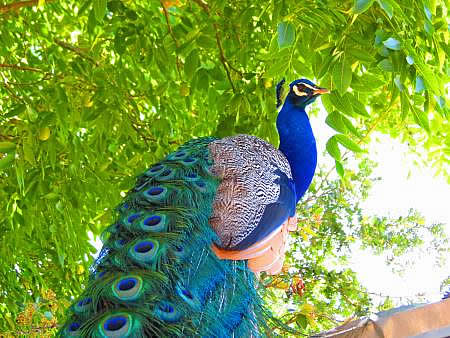
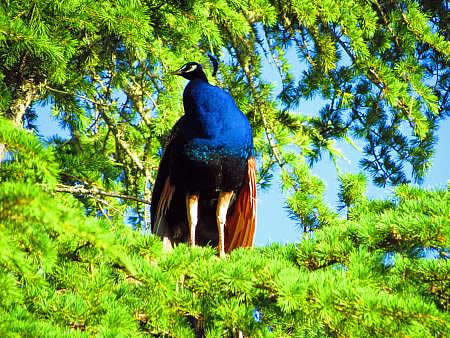
One day, while walking through CTTB and hearing the peacocks near and far, it dawned on me that these peacocks here are also reminding us to be constantly mindful! They -- together with all animals or even the irksome people around us -- might also be the transformation bodies of Buddhas and Bodhisattvas! If I can hear the Dharma in every bird call, and see the Dharma in every blade of grass, then this Saha world of ours is already the Pure Land! It all depends on the mind! I should indeed bow to all sentient beings who are here to teach us the lessons of cause and effect.
Another example. The sutras expound the merits one would receive from paying homage to the Triple Gem, from making offerings to enlightened ones and to the sangha. The sutras also taught that Dharma has no "form" -- Dharma exists in everything, everywhere, not just in Buddhist monasteries or in people wearing robes. Therefore, I am called to extend the same respect I have for an Arahant to any wholesome person; it inspires me to give dana to any endeavor that supports the growth of virtue, mindfulness, and wisdom -- no matter if they call themselves Buddhist or not. It also nudges me to treat every place -- especially Mother Nature -- like a temple, and keep it clean as I would do in a Buddha Hall. Who knows, many invisible deities may be dwelling there. Hence, "Cleanliness is next to Godliness."
I am filled with gratitude for the generations of Dharma Masters who preserved, transported, and translated the sutras, sometimes at the cost of their life. I set the intention to read all the sutras that Master Hua has commented on, as a doorway into this immense treasure.
A note on Master Hua's sutra commentaries: fifty years ago, Master Hua came to the US and taught the sutras to a group of American college students and hippies, many of whom spoke little Chinese. Therefore, his commentaries used simple language, and also served as Chinese language and culture class. Fifty years later, after the severe cultural destruction and westernization in China, the younger generation of Chinese possesses just about the same familiarity of the Chinese language and culture as the American hippies did 50 years ago. Master Hua's commentaries have become the perfect doorway for the Chinese youths to re-enter their own wisdom lineage. I have no idea whether Master Hua has "planned it all", but am certainly grateful that he has left us the "keys to the treasury" from fifty years ago!
All dharmas are equal
The Vajra Sutra says, "All dharmas are equal; there is no higher or lower." Master Hua explains, "Of the 84,000 dharma-doors taught by the Buddha, each and every one of them is the foremost dharma-door. There is no No.2. Why? If a particular dharma-door suits the composition and affinity of the student, then it is No.1. If it is not suitable, then it is not No.1."
One of Master Hua's lifelong endeavors is to bring together different lineages within Buddhism, and to build bridges between the world's religions. At CTTB, the five major schools of Mahayana Buddhism are equally valued and practices: Chan (meditation), Teaching (sutra studies), Vinaya (precepts), Secret (mantras and esoteric practices), and Pure Land (Buddha recitation).
During my stay there, I got to "sample" each of these dharma-doors briefly, and finally do my "comparison shopping" for the one that suits me most. In the process, I discovered striking similarities underlying many of the seemingly different dharma-doors. It further confirms that "all dharmas originate from the same source".
For example, in the Amitabha Sutra of the Pure Land school, it says,
"… if there is a good man or a good woman who hears ‘Amitabha’ and holds the name, whether for one day, two days, three, four, five days, six days, as long as seven days, with one heart unconfused, when this person approaches the end of life, before him will appear Amitabha and all the assembly of holy ones. When the end comes, his heart is without inversion; in Amitabha’s Land of Ultimate Bliss he will attain rebirth."
And compare that to Vipassana meditation. In the Mahasatipatthana Sutta, which is the canonical source of Vipassana technique, it says,
Indeed, monks, whoever practices this fourfold establishing of awareness in this manner for seven years, he may expect one of two results: in this very life highest wisdom or, if a substratum of aggregates remains, the stage of non-returner.
Let alone seven years, monks…
Let alone six years, monks...
Let alone seven months, monks...Let alone half a month, monks. Should any person practice this fourfold establishing of awareness in this manner for seven days, one of two results may be expected in him: in this very life highest wisdom or, if a substratum of aggregates remains, the stage of non-returner.
In both teachings, the key is to maintain constant mindfulness, to "dwell ardent with awareness and constant thorough understanding of impermanence", "with one heart unconfused". In both cases, the fruit is the non-returning stage.
The Chan (or "Zen" in Japanese) meditation is also similar to Vipassana. Vipassana (as taught by S.N. Goenka) uses "bodily sensation" (Vedana) as the object of concentration and the doorway into understanding impermanence, leading into insight. Chan uses the investigation of a "meditation topic" (Hua Tou, such as "Who is mindful of the Buddha?") as the object of concentration and to activate inherent wisdom. In both techniques, the practice is to maintain moment-to-moment awareness, whether one is walking, sitting, standing, or lying down.
It seems to my untrained eyes that, structurally, the different dharma-doors all follow to core teaching of "morality, concentration, and wisdom".
Being at CTTB also helps me to bring together the Mahayana and Theravada traditions in my own practice. For me, Mahayana teachings (the Bodhisattva path) provide the "why" -- compassion for all living beings, while the Theravada teachings (the Arahant path) provides the "how" -- a detailed meditation technique to eradicate craving from the depth of mind.
Dedication of Merit
These gifts of Dharma are just what have become known to my conscious mind. Much of what has happened during the seven weeks at CTTB remains a riddle. But even one of these visible gifts is enough to make the student eternally grateful to the Teacher, to the Triple Gem, and to the noble friends. One could only bow and resolve to pay forward the Grace that has been so generously bestowed.
Before I went into the City of Ten Thousand Buddhas, I wondered, to whom I may dedicate the merit of seven weeks of cultivation (if there was any merit…). Instantly came to mind were two dear friends/teachers -- a couple (Nipun and Guri) who have deeply nourished and guided my heart for the past three years, and, quite literally, have been my guardian angels each step along the Pilgrimage.
It turned out to be a wonderful inspiration to have them in mind as I went into CTTB, because what we would do for others is much greater than for ourselves alone. Many times, I would want to slack off during my days. Then, I would remember that all the merits of my work here would go to my dear friends, and that I shall not shortchange them. Thought of the friends has given me extra strength, and has filled everything I do with more meaning and joy.
As the lyric goes,May every living being,
Our minds as one and radiant with light,
Share the fruits of peace,
With hearts of goodness, luminous and bright.If people hear and see,
How hands and hearts can find in giving, unity,
May their minds awake,
To Great Compassion, wisdom and to joy.May kindness find reward,
May all who sorrow leave their grief and pain;
May this boundless light,
Break the darkness of their endless night.Because our hearts are one
This world of pain turns into Paradise
May all become compassionate and wise,
May all become compassionate and wise.
